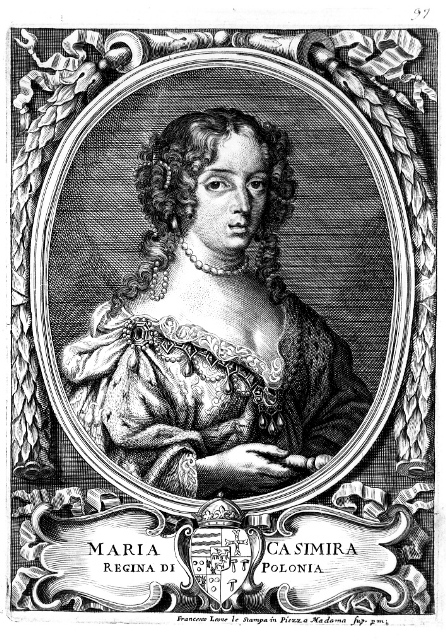
Marie Casimire (1641–1716) came to Poland with the retinue of Princess Marie Louise Gonzaga as a four-year-old beautiful girl, daughter of impoverished Henri Albert de La Grange, Marquis d'Arquien. She was soon to gain recognition in the history of Poland, first as the wife of Senior Registrar Zamoyski and later the wife of Jan Sobieski, initially hetman and eventually the King of Poland. The beloved spouse of King Jan III occupied a prominent place in his life and letters, which were opened with invocations like, “Sweet Marie, the love of my heart and soul”, “The only love of my soul and heart” or “My one and only heart”. Not for nothing did enamoured Sobieski address her as “the fairest Aurora”, as Marie Casimire was indeed of stunning beauty. Very regular features and dazzling complexion of her face were coupled with big black eyes of an intense look, both blazing and daydreaming. The queen relished splendid garments and jewellery and in her dress she followed the French fashion. She carefully observed personal hygiene, which was not common practice in her times. At least thirty oil portraits extant in Polish and foreign collections bear testimony to the queen’s exceptional beauty.
Most of her printed images, between ten and twenty in total, were made in 1696–1700, i.e. the time when she became a widow. Unlike oil portraits, nearly all graphic ones were executed abroad and commissioned from Dutch artists (Romeyn de Hooghe, Gelliam van der Gouwen, Pieter Stevens, Jacob Gole) or French (Benoît Farjat, Siméon Thomassin, Hubert Vincent), Flemish (Jacques Blondeau) and Italian printmakers active in Rome. The latter’s achievements include a rare anonymous copperplate engraving impressed in the engraving shop of Francesco Leone in Rome at the turn of the seventeenth and the eighteenth centuries, displaying clear analogy with Blondeau’s print. Slightly different in the model’s pose, the two copperplate engravings have common elements like elaborate curls plaited with numerous pearls which also decorate the model’s dress. The discussed print belongs to the collection of Emeryk Hutten-Czapski Junior and was purchased from Marek Potocki for the National Library prints collection in an auction held in Warsaw in 1998. The prototype for Blondeau’s and Leone’s prints, copied as mirror images, could be two extant oil paintings by an unidentified French author active in 1675–1700: a piece in the State Collection of Art in Wawel (ca. 1684) and its replica from ca. 1685 kept in the Wilanów Palace Museum.
An anonymous Italian engraver, print shop of Francesco Leone in Rome: Portrait of Queen Marie Casimire, copperplate engraving, turn of the seventeenth and the eighteenth centuries.
We would like to inform that for the purpose of optimisation of content available on our website and its customisation according to your needs, we use information stored by means of cookies on the Users' end devices. You can control cookies by means of your Internet browser settings. Further use of our website without change of the browser settings means that you accept the use of cookies. For more information on cookies used by us and to feel comfortable about this subject, please familiarise yourselves with our Privacy Policy.
✓ I understand